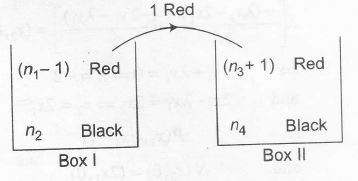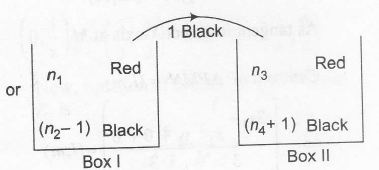Answer:
Option C,D
Explanation:


$\therefore$ P (drawing red ball from B1)= $\frac{1}{3}$
$\Rightarrow$ $\left(\frac{n_{1}-1}{n_{1}+n_{2}-1}\right)\left(\frac{n_{1}}{n_{1}+n_{2}}\right)+\left(\frac{n_{2}}{n_{1}+n_{2}}\right)\left(\frac{n_{1}}{n_{1}+n_{2}-1}\right)=\frac{1}{3}$
$\Rightarrow$ $\frac{n_1^2+n_{1}.n_{2}-n_{1}}{(n_{1}+n_{2})(n_{1}+n_{2}-1)}=\frac{1}{3}$
Clearly, options (c) and (d) satisfy